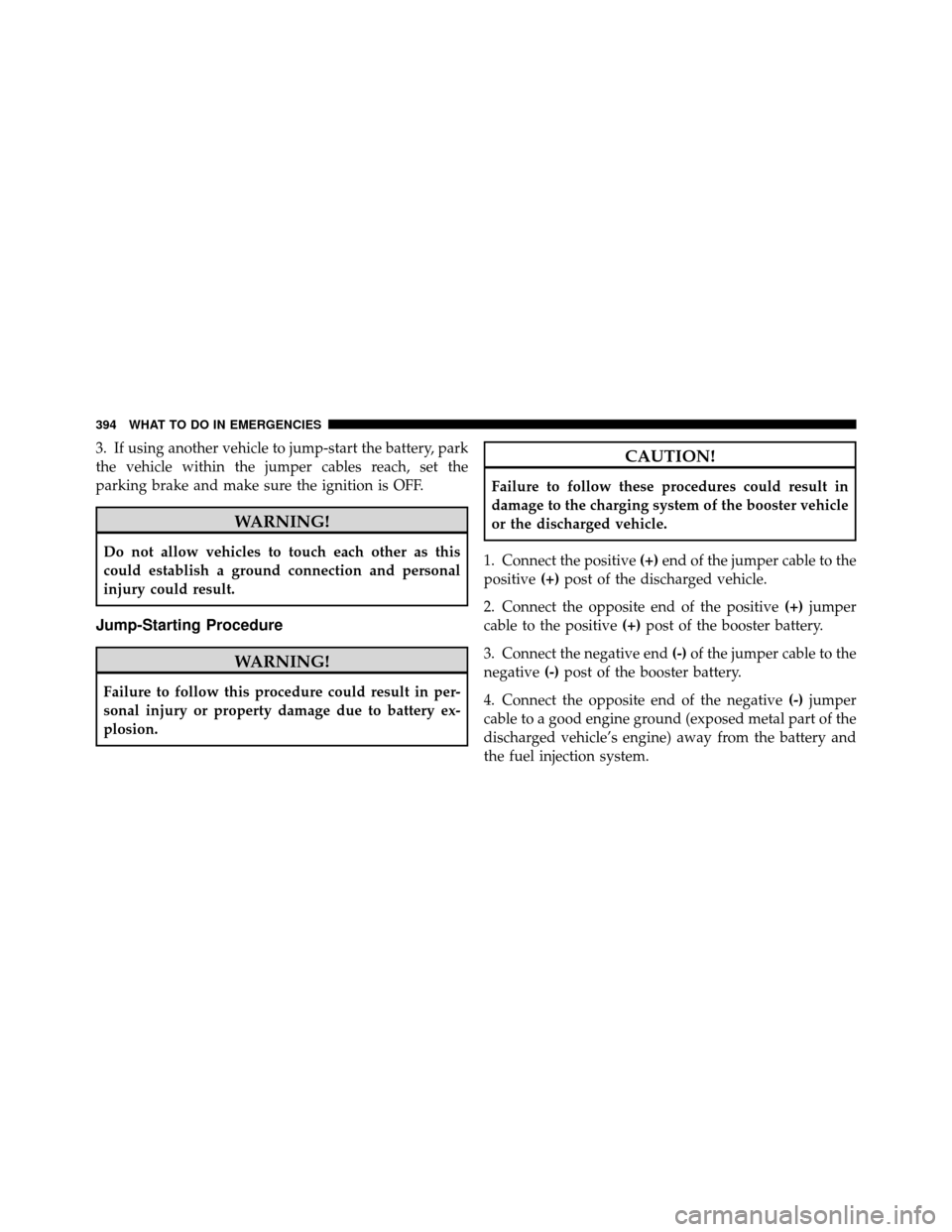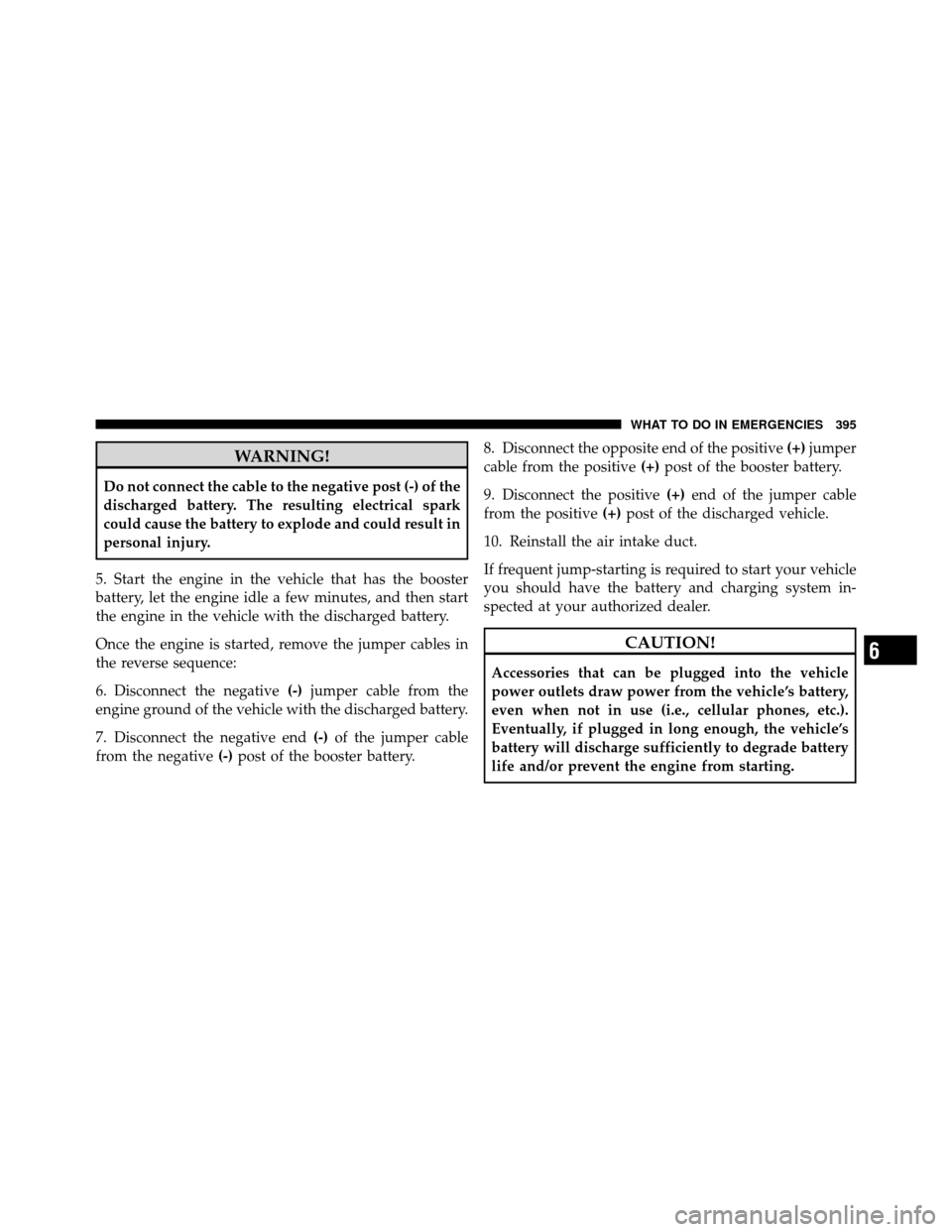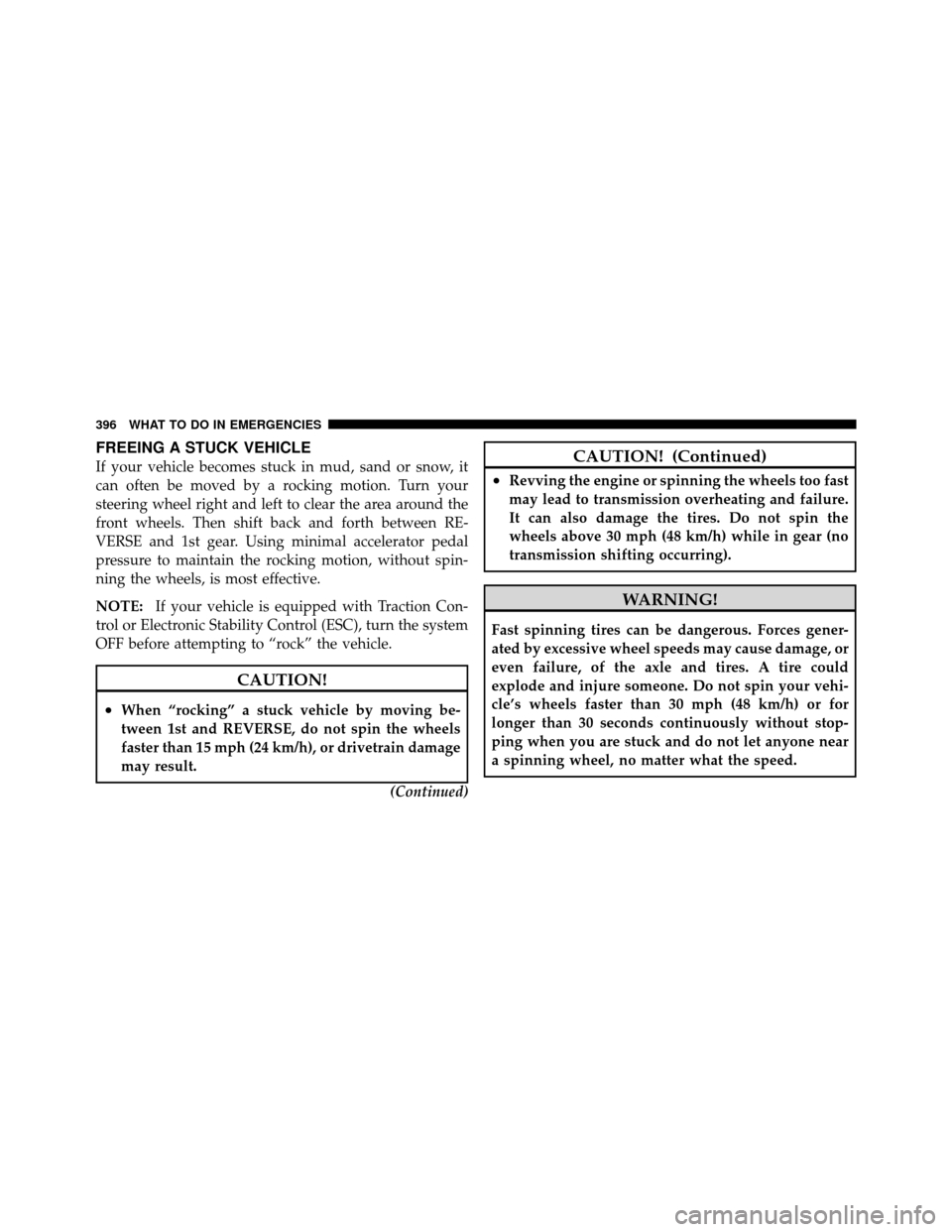Page 393 of 496
WARNING!
Do not attempt jump-starting if the battery is frozen.
It could rupture or explode and cause personal injury.
Preparations for Jump-Start
The battery in your vehicle is located in the front of the
engine compartment below the air intake duct. To access
the battery remove the air intake duct by turning the two
finger screws, located on the radiator support.
Air Intake Finger Screws
392 WHAT TO DO IN EMERGENCIES
Page 395 of 496

3. If using another vehicle to jump-start the battery, park
the vehicle within the jumper cables reach, set the
parking brake and make sure the ignition is OFF.
WARNING!
Do not allow vehicles to touch each other as this
could establish a ground connection and personal
injury could result.
Jump-Starting Procedure
WARNING!
Failure to follow this procedure could result in per-
sonal injury or property damage due to battery ex-
plosion.
CAUTION!
Failure to follow these procedures could result in
damage to the charging system of the booster vehicle
or the discharged vehicle.
1. Connect the positive (+)end of the jumper cable to the
positive (+)post of the discharged vehicle.
2. Connect the opposite end of the positive (+)jumper
cable to the positive (+)post of the booster battery.
3. Connect the negative end (-)of the jumper cable to the
negative (-)post of the booster battery.
4. Connect the opposite end of the negative (-)jumper
cable to a good engine ground (exposed metal part of the
discharged vehicle’s engine) away from the battery and
the fuel injection system.
394 WHAT TO DO IN EMERGENCIES
Page 396 of 496

WARNING!
Do not connect the cable to the negative post (-) of the
discharged battery. The resulting electrical spark
could cause the battery to explode and could result in
personal injury.
5. Start the engine in the vehicle that has the booster
battery, let the engine idle a few minutes, and then start
the engine in the vehicle with the discharged battery.
Once the engine is started, remove the jumper cables in
the reverse sequence:
6. Disconnect the negative (-)jumper cable from the
engine ground of the vehicle with the discharged battery.
7. Disconnect the negative end (-)of the jumper cable
from the negative (-)post of the booster battery. 8. Disconnect the opposite end of the positive
(+)jumper
cable from the positive (+)post of the booster battery.
9. Disconnect the positive (+)end of the jumper cable
from the positive (+)post of the discharged vehicle.
10. Reinstall the air intake duct.
If frequent jump-starting is required to start your vehicle
you should have the battery and charging system in-
spected at your authorized dealer.
CAUTION!
Accessories that can be plugged into the vehicle
power outlets draw power from the vehicle’s battery,
even when not in use (i.e., cellular phones, etc.).
Eventually, if plugged in long enough, the vehicle’s
battery will discharge sufficiently to degrade battery
life and/or prevent the engine from starting.
6
WHAT TO DO IN EMERGENCIES 395
Page 397 of 496

FREEING A STUCK VEHICLE
If your vehicle becomes stuck in mud, sand or snow, it
can often be moved by a rocking motion. Turn your
steering wheel right and left to clear the area around the
front wheels. Then shift back and forth between RE-
VERSE and 1st gear. Using minimal accelerator pedal
pressure to maintain the rocking motion, without spin-
ning the wheels, is most effective.
NOTE:If your vehicle is equipped with Traction Con-
trol or Electronic Stability Control (ESC), turn the system
OFF before attempting to “rock” the vehicle.
CAUTION!
•When “rocking” a stuck vehicle by moving be-
tween 1st and REVERSE, do not spin the wheels
faster than 15 mph (24 km/h), or drivetrain damage
may result.
(Continued)
CAUTION! (Continued)
•Revving the engine or spinning the wheels too fast
may lead to transmission overheating and failure.
It can also damage the tires. Do not spin the
wheels above 30 mph (48 km/h) while in gear (no
transmission shifting occurring).
WARNING!
Fast spinning tires can be dangerous. Forces gener-
ated by excessive wheel speeds may cause damage, or
even failure, of the axle and tires. A tire could
explode and injure someone. Do not spin your vehi-
cle’s wheels faster than 30 mph (48 km/h) or for
longer than 30 seconds continuously without stop-
ping when you are stuck and do not let anyone near
a spinning wheel, no matter what the speed.
396 WHAT TO DO IN EMERGENCIES
Page 400 of 496
MAINTAINING YOUR VEHICLE
CONTENTS
�Engine Compartment — 2.0L ............. 401
� Engine Compartment — 2.4L ............. 402
� Onboard Diagnostic System — OBD II ...... 403
▫ Loose Fuel Filler Cap Message ........... 403
� Emissions Inspection And Maintenance
Programs ............................ 404
� Replacement Parts ..................... 405
� Dealer Service ........................ 406
� Maintenance Procedures ................. 406 ▫
Engine Oil ......................... 407
▫ Engine Oil Filter ..................... 409
▫ Engine Air Cleaner Filter ............... 410
▫ Maintenance-Free Battery .............. 410
▫ Air Conditioner Maintenance ............ 412
▫ Body Lubrication .................... 413
▫ Windshield Wiper Blades ............... 413
▫ Adding Washer Fluid ................. 414
▫ Exhaust System ..................... 414
7
Page 401 of 496

▫Cooling System ..................... 417
▫ Brake System ....................... 422
▫ Automatic Transmission (CVT) –
If Equipped ........................ 425
▫ Manual Transmission – If Equipped ....... 426
▫ Rear Drive Assembly (RDA) – AWD/4WD
Models Only ....................... 427
▫ Power Transfer Unit (PTU) – AWD/4WD
Models Only ....................... 427
▫ Appearance Care And Protection From
Corrosion .......................... 428
� Fuses .............................. 433
▫ Integrated Power Module (IPM) .......... 433�
Vehicle Storage ....................... 437
� Replacement Bulbs .................... 437
� Bulb Replacement ..................... 438
▫ Headlamps ........................ 438
▫ Fog Lamps ......................... 441
▫ Tail Lamps, Rear Turn Signals And Backup
Lamps ............................ 441
▫ License Lamps ...................... 441
▫ Center High-Mounted Stoplamp ......... 442
� Fluid Capacities ...................... 443
� Fluids, Lubricants, And Genuine Parts ....... 444
▫ Engine ............................ 444
▫ Chassis ........................... 445
400 MAINTAINING YOUR VEHICLE
Page 402 of 496
ENGINE COMPARTMENT — 2.0L
1 — Washer Fluid Reservoir6 — Integrated Power Module
2 — Power Steering Fluid Reservoir 7 — Battery (Under Cover)
3 — Engine Oil Fill 8 — Coolant Pressure Cap
4 — Air Cleaner Filter 9 — Engine Oil Dipstick
5 — Brake Fluid Reservoir 10 — Engine Coolant Reservoir
7
MAINTAINING YOUR VEHICLE 401
Page 403 of 496
ENGINE COMPARTMENT — 2.4L
1 — Washer Fluid Reservoir6 — Battery (Under Cover)
2 — Power Steering Fluid Reservoir 7 — Air Cleaner Filter
3 — Engine Oil Fill 8 — Coolant Pressure Cap
4 — Brake Fluid Reservoir 9 — Engine Oil Dipstick
5 — Integrated Power Module 10 — Engine Coolant Reservoir
402 MAINTAINING YOUR VEHICLE